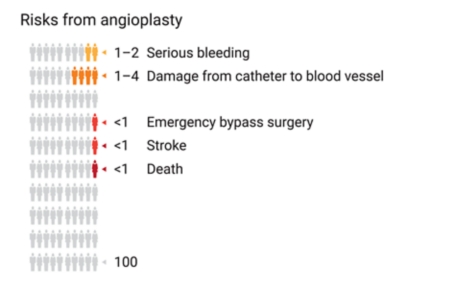Angioplasty risks

Out of 100 people who have had a coronary angioplasty for stable angina:
- About 1 or 2 people had a serious bleeding problem from the procedure.
- About 1 to 4 people had damage to a blood vessel from the catheter.
- Fewer than 1 out of 100 people (4 out of 1,000) had emergency bypass surgery.
- Fewer than 1 out of 100 (2 out of 1,000) had a stroke.
- Fewer than 1 out of 100 (1 out of 1,000) died.
These numbers about risks come from problems seen in patients in hospitals.
Current as of: July 31, 2024
Author: Ignite Healthwise, LLC Staff
Clinical Review Board
All Ignite Healthwise, LLC education is reviewed by a team that includes physicians, nurses, advanced practitioners, registered dieticians, and other healthcare professionals.
Current as of: July 31, 2024
Lichtman JH, et al. (2014). Age and sex differences in inhospital complications rates and mortality after percutaneous coronary intervention procedures: Evidence from the NCDR. American Heart Journal, 167(3): 376-83. DOI: 10.1016/j.ahj.2013.11.001. Accessed March 23, 2017.
Subherwal S, et al. (2012). Temporal trends in and factors associated with bleeding complications among patients undergoing percutaneous coronary intervention. Journal of the American College of Cardiology, 59(21): 1861–1869. DOI: 10.1016/j.jacc.2011.12.046. Accessed October 16, 2015.
Bernat I, et al. (2019) Best practices for the prevention of radial artery occlusion after transradial diagnostic angiography and intervention: An international consensus paper. Journal of the American College of Cardiology: Cardiovascular Interventions, 12(22): 2235–2246. DOI: 10.1016/j.jcin.2019.07.043. Accessed July 6, 2020.
Kutcher MA, et al. (2009). Percutaneous coronary interventions in facilities without cardiac surgery on site: A report from the National Cardiovascular Data Registry (NCDR). Journal of the American College of Cardiology, 54(1): 16–24. DOI: 10.1016/j.jacc.2009.03.038. Accessed March 23, 2017.
Aggarwal A, et al (2009). Incidence and predictors of stroke associated with percutaneous coronary intervention. American Journal of Cardiology, 104 (3): 349-53. DOI: 10.1016/j.amjcard.2009.03.046. Accessed March 23, 2017.
Vora AN, et al. (2016). Temporal trends in the risk profile of patients undergoing outpatient percutaneous coronary intervention. Circulation Cardiovascular Interventions, 9(3): e003070. DOI: 10.1161/CIRCINTERVENTIONS.115.003070. Accessed March 23, 2017.
